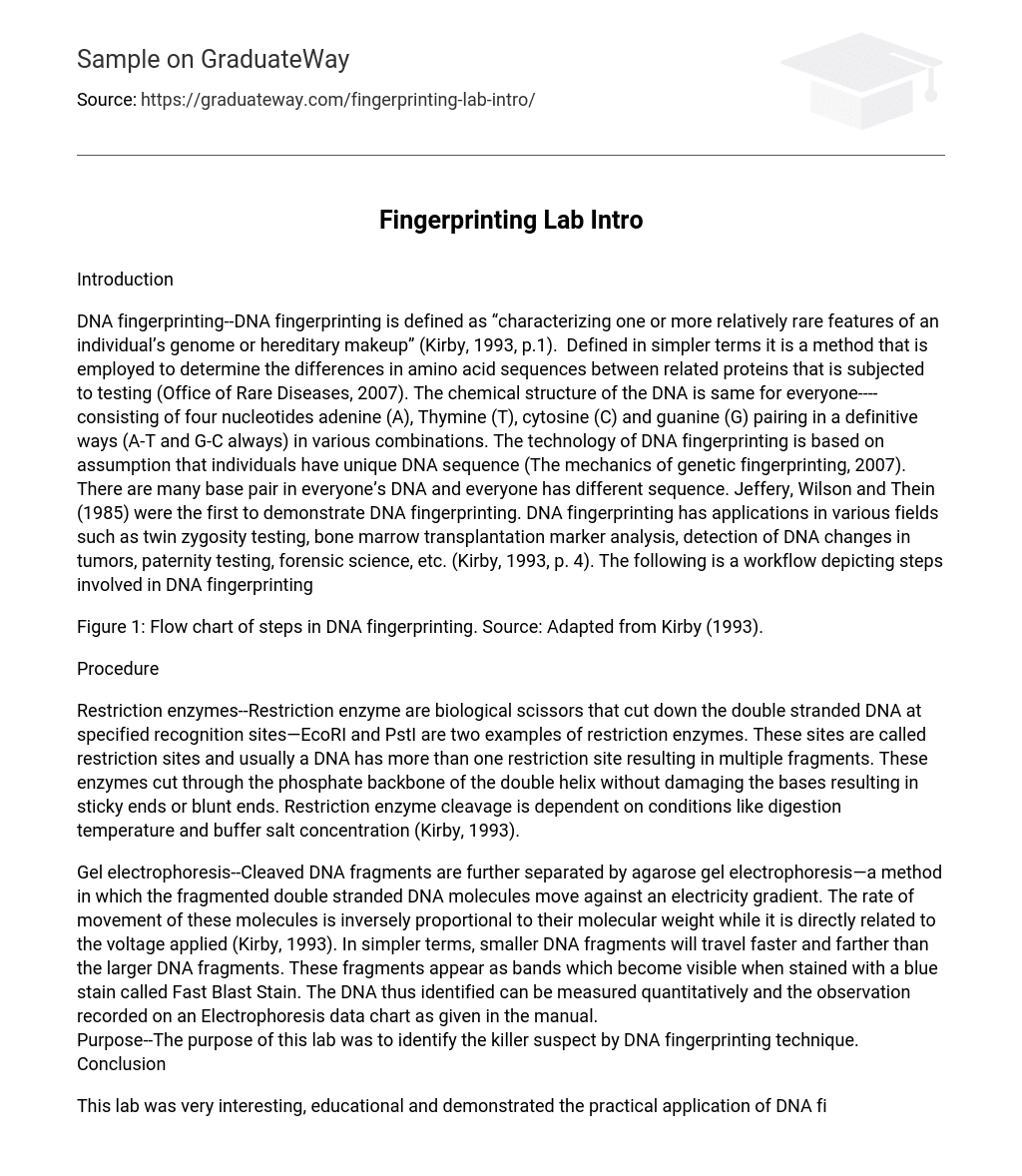Introduction DNA fingerprinting–DNA fingerprinting is defined as “characterizing one or more relatively rare features of an individual’s genome or hereditary makeup” (Kirby, 1993, p.1). Defined in simpler terms it is a method that is employed to determine the differences in amino acid sequences between related proteins that is subjected to testing (Office of Rare Diseases, 2007). The chemical structure of the DNA is same for everyone—-consisting of four nucleotides adenine (A), Thymine (T), cytosine (C) and guanine (G) pairing in a definitive ways (A-T and G-C always) in various combinations. The technology of DNA fingerprinting is based on assumption that individuals have unique DNA sequence (The mechanics of genetic fingerprinting, 2007).
There are many base pair in everyone’s DNA and everyone has different sequence. Jeffery, Wilson and Thein (1985) were the first to demonstrate DNA fingerprinting. DNA fingerprinting has applications in various fields such as twin zygosity testing, bone marrow transplantation marker analysis, detection of DNA changes in tumors, paternity testing, forensic science, etc. (Kirby, 1993, p. 4).
The following is a workflow depicting steps involved in DNA fingerprinting Figure 1: Flow chart of steps in DNA fingerprinting. Source: Adapted from Kirby (1993). Procedure Restriction enzymes–Restriction enzyme are biological scissors that cut down the double stranded DNA at specified recognition sites—EcoRI and PstI are two examples of restriction enzymes. These sites are called restriction sites and usually a DNA has more than one restriction site resulting in multiple fragments. These enzymes cut through the phosphate backbone of the double helix without damaging the bases resulting in sticky ends or blunt ends. Restriction enzyme cleavage is dependent on conditions like digestion temperature and buffer salt concentration (Kirby, 1993).
Gel electrophoresis–Cleaved DNA fragments are further separated by agarose gel electrophoresis—a method in which the fragmented double stranded DNA molecules move against an electricity gradient. The rate of movement of these molecules is inversely proportional to their molecular weight while it is directly related to the voltage applied (Kirby, 1993). In simpler terms, smaller DNA fragments will travel faster and farther than the larger DNA fragments. These fragments appear as bands which become visible when stained with a blue stain called Fast Blast Stain. The DNA thus identified can be measured quantitatively and the observation recorded on an Electrophoresis data chart as given in the manual.
Purpose–The purpose of this lab was to identify the killer suspect by DNA fingerprinting technique. Conclusion This lab was very interesting, educational and demonstrated the practical application of DNA fingerprinting technique to find the killer. Using this technique, suspect 3 was identified as criminal because its DNA fragments matched with the DNA fragments collected on the crime scene. It was also found that the length of the DNA fragments were of the same size as the once found on the crime scene, proving that suspect 3 was the criminal. References Jeffreys A.
J., Wilson, V., & Thein S. L. (1985). Individual specific fingerprints of Human DNA.
Nature, 316 (6023): 76–79 Kirby, L. T. (Ed.) (1993). DNA fingerprinting : An introduction (368 pp).
Cary, NC, USA: Oxford University Press, Inc. Retrieved May 13, 2007, from http://site.ebrary.com/lib/uclan/Doc?id=10087251&ppg=18. Office of Rare Diseases. (2007). National Institute of Health.
Retrieved May 13, 2007, from http://ord.aspensys.com/asp/resources/glossary_a-e.asp. The mechanics of genetic fingerprinting. (2007). Retrieved May 13, 2007, from http://science.jrank.org/pages/2128/DNA-Fingerprinting-mechanics-genetic-fingerprinting.html





